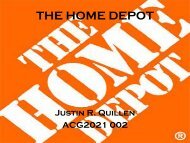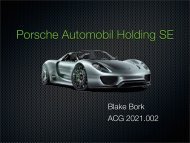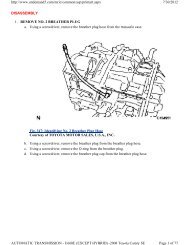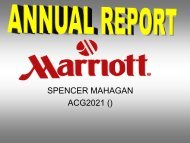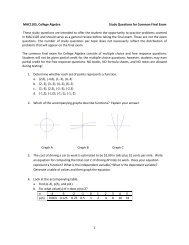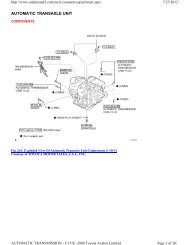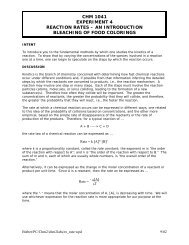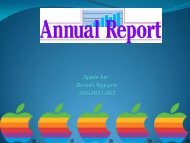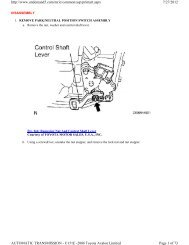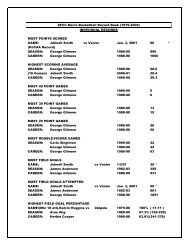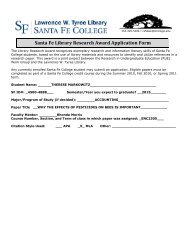BEST BUY ANNUAL REPORT
BEST BUY ANNUAL REPORT
BEST BUY ANNUAL REPORT
Create successful ePaper yourself
Turn your PDF publications into a flip-book with our unique Google optimized e-Paper software.
Best Buy has shown that their business is growing<br />
each year. Their financial statements are healthy<br />
and growing positively. Even though, the U.S.<br />
economy is facing a downturn Best Buy is trying to<br />
keep their revenues high. In my own opinion, they<br />
will continue to grow because they have solid<br />
financial statements that will help stabilize the<br />
downturn of the U.S. economy.<br />
Best Buy 2006 Annual Report Links:<br />
PDF<br />
HTML
Mr. Bradbury H. Anderson<br />
Richfield, Minnesota, USA<br />
Ending date of latest fiscal year: March 3, 2007<br />
Best Buy specializes in selling consumer<br />
electronics, home-office products,<br />
entertainment software, appliances, and<br />
related services<br />
Main geographic area of activity is the United<br />
States
Deloitte & Touche.<br />
The company is healthy and growing. Their<br />
financial statements are solid and they will<br />
continue expanding their business amid the<br />
U.S. economic situation.
Stock Price: 46.45<br />
12 month range: 41.85 - 53.90<br />
Dividend per share: 0.52 (1.10%)<br />
February 07, 2008<br />
Your opinion about the company stock as an<br />
investment? <strong>BUY</strong>/HOLD
CEA: Consumer Electronics Association Website: http://www.ce.org
• Multistep format<br />
• The increase in the three digits shows the expansion that<br />
Best Buy is having. They reported gains as they continue<br />
expanding their business. This demonstrates that the<br />
consumer electronic industry is increasing. Therefore, more<br />
stores have to be opened in order to increase their gains.<br />
2006 2005<br />
Gross Margin 8,769,000 7,726,000<br />
Income from<br />
operations<br />
1,999,000 1,644,000<br />
Net income 1,377,000 1,140,000
Assets Liabilities Stockholders<br />
Equity<br />
2005 11,864,000 6,607,000 5,257,000<br />
2006 13,570,000 7,369,000 6,201,000<br />
• In assets, cash and inventory increases helped assets to raise<br />
their numbers at the end of the year. Helping assets to have<br />
the largest change.<br />
• The liabilities increase was primarily cause by an increase in<br />
account payable and long term debt.<br />
• The stockholders equity was raised because of the increase in<br />
retained earnings.
•Cash flows for operations were more than net income in both<br />
years, 2005 and 2006.<br />
•The company is definitely growing through investing activities.<br />
They have invested in new stores and inventory. However, the<br />
major growing sector is retained revenues.<br />
•The company’s primary source of financing are the long term<br />
loans.<br />
•Cash increased in the past two years.
• Revenue recognition: They recognize revenue when the sales<br />
price is fixed or determinable, collectability is reasonably assured<br />
and the customer takes possession of the merchandise, or in the<br />
case of services, at the time the service is provided.<br />
• Cash and cash equivalents: Cash primarily consists of cash on<br />
hand and bank deposits. Cash equivalents primarily consist of<br />
money market accounts and other highly liquid investments.<br />
• Inventories: Merchandise inventories are recorded at the lower of<br />
average cost or market. Inventory loss reserve represents<br />
anticipated physical inventory losses that have occurred since the<br />
last physical inventory date.<br />
• Property and equipment: Property and equipment are recorded<br />
at cost. They compute depreciation using the straight-line method<br />
over the estimated useful lives of the assets.
Accounting Policies<br />
Discontinued Operations<br />
Acquisitions<br />
Investments<br />
Debt<br />
Shareholders’ Equity<br />
Net Interest Income<br />
Leases<br />
Benefit Plans<br />
Income Taxes<br />
Segment and Geographic Information<br />
Contingencies and Commitments<br />
Related Party Transactions<br />
Condensed Consolidating Financial Information<br />
Subsequent Event<br />
Supplementary Financial Information (Unaudited)
Working Capital (in millions):<br />
2006: 1,929 2005: 1,944<br />
The Working Capital had a slight decreased in 2006<br />
because of the increase in liabilities.<br />
Current Ratio :<br />
2006: 1.32 2005: 1.39<br />
The Current Ratio decreased, suggesting that liabilities are<br />
increasing.<br />
Receivable turnover:<br />
2006: 1.15 2005: 1.04<br />
The Receivable turnover increased implying that the<br />
company has less time is needed to collect accounts.
Average days’ sales uncollected:<br />
2006: 5.99 2005: 4.99<br />
This measures how many days it takes to collect the average<br />
account receivables. In 2006, it increased 1 day.<br />
Inventory turnover:<br />
2006: 7.47 2005: 7.67<br />
Measures how many times the company sold through its<br />
inventory this year. Since it decreased this assesses that the<br />
efficiency in the management inventory was better.<br />
Average days’ inventory on hand:<br />
2006: 48.86 2005: 47.59<br />
Since it increased this indicates that sales slowed down.
Profit margin:<br />
2006: 3.69% 2005: 3.59%<br />
This shows that the firm increased the amount of dollars earned for every dollar<br />
in revenues.<br />
Asset turnover:<br />
2006: 2.78 2005: 2.89<br />
Since it decreased, it means that the company generated less net sales for each<br />
dollar in assets used in business.<br />
Return on assets:<br />
2006: 10.29% 2005: 10.39%<br />
Since there is a slight decrease, the company earned less income for every<br />
dollar on assets.<br />
Return on equity:<br />
2006: 23.49% 2005: 25.00%<br />
The profitability of the investment by the commons stockholders decreased.
Debt to equity:<br />
2006: 1.15 2005: 1.11<br />
This suggests that the company is controlled by the<br />
creditors. There are more liabilities than<br />
stockholder’s equity. Furthermore, the ratio<br />
appears to be increasing meaning that or<br />
liabilities are increasing or investors are taking out<br />
their money.
For the past two years, calculate and comment<br />
on:<br />
Price/earnings per share:<br />
2006: $2.33 2005: $1.91<br />
There was a $0.39 increase in earning per<br />
share; therefore, the stocks have strengthened.<br />
Dividend yield:<br />
2006: 0.8% 2005: 0.8%<br />
Dividend yield remained unchanged.



